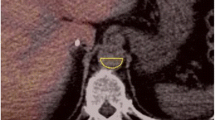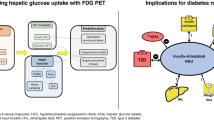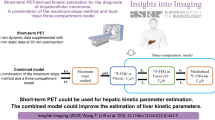Abstract
Purpose
The liver is perfused through the portal vein and hepatic artery. Quantification of hepatic glucose uptake (HGU) using PET requires the use of an input function for both the hepatic artery and portal vein. The former can be generally obtained invasively, but blood withdrawal from the portal vein is not practical in humans. The aim of this study was to develop and validate a new technique to obtain quantitative HGU by estimating the input function from PET images.
Methods
Normal pigs (n = 12) were studied with [18F]FDG PET, in which arterial and portal blood time-activity curves (TAC) were determined invasively to serve as reference measurements. The present technique consisted of two characteristics, i.e. using a model input function and simultaneously fitting multiple liver tissue TACs from images by minimizing the residual sum of square between the tissue TACs and fitted curves. The input function was obtained from the parameters determined from the fitting. The HGU values were computed by the estimated and measured input functions and compared between the methods.
Results
The estimated input functions were well reproduced. The HGU values, ranging from 0.005 to 0.02 ml/min per ml, were not significantly different between the two methods (r = 0.95, p < 0.001). A Bland-Altman plot demonstrated a small overestimation by the image-derived method with a bias of 0.00052 ml/min per g for HGU.
Conclusion
The results presented demonstrate that the input function can be estimated directly from the PET image, supporting the fully non-invasive assessment of liver glucose metabolism in human studies.







Similar content being viewed by others
References
Alenius S, Ruotsalainen U. Bayesian image reconstruction for emission tomography based on median root prior. Eur J Nucl Med 1997;24:258–65.
Basu A, Basu R, Shah P, Vella A, Johnson CM, Nair KS, et al. Effects of type 2 diabetes on the ability of insulin and glucose to regulate splanchnic and muscle glucose metabolism: evidence for a defect in hepatic glucokinase activity. Diabetes 2000;49:272–83.
Di Bella EV, Clackdoyle R, Gullberg GT. (1999) Blind estimation of compartmental model parameters. Phys Med Biol 1999;44:765–80.
Choi Y, Hawkins RA, Huang SC, Brunken RC, Hoh CK, Messa C, et al. Evaluation of the effect of glucose ingestion and kinetic model configurations of FDG in the normal liver. J Nucl Med 1994;35:818–23.
Eriksson L, Kanno I. Blood sampling devices and measurements. Med Prog Technol 1991;17:249–57.
Ferre T, Riu E, Franckhauser S, Agudo J, Bosch F. Long-term overexpression of glucokinase in the liver of transgenic mice leads to insulin resistance. Diabetologia 2003;46:1662–8.
Gjedde A. Calculation of cerebral glucose phosphorylation from brain uptake of glucose analogs in vivo: a re-examination. Brain Res 1982;257:237–74.
Iida H, Kanno I, Miura S, Murakami M, Takahashi K, Uemura K. Error analysis of a quantitative cerebral blood flow measurement using H2(15)O autoradiography and positron emission tomography, with respect to the dispersion of the input function. J Cereb Blood Flow Metab 1986;6:536–45.
Iida H, Higano S, Tomura N, Shishido F, Kanno I, Miura S, et al. Evaluation of regional differences of tracer appearance time in cerebral tissues using [15O] water and dynamic positron emission tomography. J Cereb Blood Flow Metab 1988;8:285–8.
Iozzo P, Hallsten K, Oikonen V, Virtanen KA, Kemppainen J, Solin O, et al. Insulin-mediated hepatic glucose uptake is impaired in type 2 diabetes: evidence for a relationship with glycemic control. J Clin Endocrinol Metab 2003;88:2055–60.
Iozzo P, Geisler F, Oikonen V, Maki M, Takala T, Solin O, et al. Insulin stimulates liver glucose uptake in humans: an 18F-FDG PET Study. J Nucl Med 2003;44:682–9.
Iozzo P, Gastaldelli A, Järvisalo MJ, Kiss J, Borra R, Buzzigoli E, et al. 18F-FDG assessment of glucose disposal and production rates during fasting and insulin stimulation: a validation study. J Nucl Med 2006;47:1016–22.
Iozzo P, Jarvisalo MJ, Kiss J, Borra R, Naum GA, Viljanen A, et al. Quantification of liver glucose metabolism by positron emission tomography: validation study in pigs. Gastroenterology 2007;132:531–42.
Juillard L, Janier M, Fouque D, Lionnet M, Le Bars D, Cinotti L, et al. Renal blood flow measurement by positron emission tomography using 15O-labeled water. Kidney Int 2000;57:2511–8.
Kanno I, Iida H, Miura S, Murakami M, Takahashi K, Sasaki H, et al. A system for cerebral blood flow measurement using an H215O autoradiographic method and positron emission tomography. J Cereb Blood Flow Metab 1987;7:143–53.
Kudomi N, Choi E, Watabe H, Kim KM, Shidahara M, Ogawa M, et al. Development of a GSO detector assembly for a continuous blood sampling system. IEEE Trans Nucl Sci 2003;50:70–73.
Kudomi N, Slimani L, Järvisalo MJ, Kiss J, Lautamäki R, Naum GA, et al. Non-invasive estimation of hepatic blood perfusion from H2 15O PET images using tissue-derived arterial and portal input functions. Eur J Nucl Med Mol Imaging 2008;35:1899–911.
Munk OL, Bass L, Roelsgaard K, Bender D, Hansen SB, Keiding S. Liver kinetics of glucose analogs measured in pigs by PET: importance of dual-input blood sampling. J Nucl Med 2001;42:795–801.
Naganawa M, Kimura Y, Nariai T, Ishii K, Oda K, Manabe Y, et al. Omission of serial arterial blood sampling in neuroreceptor imaging with independent component analysis. Neuroimage 2005;26:885–90.
Naganawa M, Kimura Y, Ishii K, Oda K, Ishiwata K, Matani A. Extraction of a plasma time-activity curve from dynamic brain PET images based on independent component analysis. IEEE Trans Biomed Eng 2005;52:201–10.
Patlak CS, Blasberg RG, Fenstermacher JD. Graphical evaluation of blood-to-brain transfer constants from multiple-time uptake data. J Cereb Blood Flow Metab 1983;3:1–7.
Patlak CS, Blasberg RG. Graphical evaluation of blood-to-brain transfer constants from multiple-time uptake data. Generalizations. J Cereb Blood Flow Metab 1985;5:584–90.
Ruotsalainen U, Raitakari M, Nuutila P, Oikonen V, Sipilä H, Teräs M, et al. Quantitative blood flow measurement of skeletal muscle using oxygen-15-water and PET. J Nucl Med 1997;38:314–9.
Sanabria-Bohórquez SM, Maes A, Dupont P, Bormans G, de Groot T, Coimbra A, et al. Image-derived input function for [11C]flumazenil kinetic analysis in human brain. Mol Imaging Biol 2003;5:72–8.
van der Weerdt A, Klein LJ, Boellaard R, Visser CA, Visser FC, Lammertsma AA. Image-derived input functions for determination of MRGlu in cardiac (18)F-FDG PET scans. J Nucl Med 2001;42:1622–9.
Varga J, Szabo Z. Modified regression model for the Logan plot. J Cereb Blood Flow Metab 2002;22:240–4.
Votaw JR, Shulman SD. Performance evaluation of the Pico-Count flow-through detector for use in cerebral blood flow PET studies. J Nucl Med 1998;39:509–15.
Watabe H, Channing MA, Riddell C, Jousse F, Libutti SK, Carrasquillo JA, et al. Noninvasive estimation of the aorta input function for measurement of tumor blood flow with. IEEE Trans Med Imaging 2001;20:164–74.
Acknowledgments
The authors thank the technical staff of the Turku PET Centre for the efforts and skills dedicated to this project. The study was conducted within the “Centre of Excellence in Molecular Imaging in Cardiovascular and Metabolic Research" supported by the Academy of Finland, University of Turku, Turku University Hospital and Abo Academy. This work is part of the project Hepatic and Adipose Tissue and Functions in the Metabolic Syndrome (HEPADIP), which is supported by the European Commission as an Integrated Project under the 6th Framework Programme (contract LSHMCT-2005-018734). The study was further supported by grants from the Finnish Diabetes Foundation (P.I.), EFSD/Eli-Lilly (P.I.), Sigrid Juselius Foundation (N.K.), and Novo Nordisk Foundation (P.N.).
Author information
Authors and Affiliations
Corresponding author
Appendix
Appendix
A model function for hepatic input function for 18FDG was created, by assuming a three-compartment model, in which the tracer is administered in a rectangular form and diffuses bidirectionally between arterial blood and whole-body peripheral tissue compartments. Part of the tracer is metabolized and accumulated in the third compartment. Differential equations for the model function (C I(t)) can be expressed as;
where t 1 assumes the appearance time of administered tracer and t 2-t 1 represents the administration duration, A is scalar of input function. The equation F (Eq. 7) represents the bolus administration of tracer in the rectangular form with duration t 2-t 1. C WB(t) is the expected tracer concentration in whole-body peripheral tissues, K E and K I are bidirectional tracer diffusion rates between blood and peripheral tissue compartments, respectively, and K M is the metabolic rate of the tracer in assumed whole body. Solving Eq. 6 for C WB gives:
The sum of Eq. 5 and a × Eq. 6 generates:
where
Thus,
where ⊗ indicates convolution integral. Substitution of C WB from Eq. 8 into Eq. 11 after multiplying e (KI+KM)·t gives:
Differentiation with respect to t after arrangement gives:
Thus,
where β=(K I /a+K E ). Solving Eq. 14, we obtain:
where α= K I /K E and γ=(K I /a+aK E ).
Rights and permissions
About this article
Cite this article
Kudomi, N., Järvisalo, M.J., Kiss, J. et al. Non-invasive estimation of hepatic glucose uptake from [18F]FDG PET images using tissue-derived input functions. Eur J Nucl Med Mol Imaging 36, 2014–2026 (2009). https://doi.org/10.1007/s00259-009-1140-y
Received:
Accepted:
Published:
Issue Date:
DOI: https://doi.org/10.1007/s00259-009-1140-y




